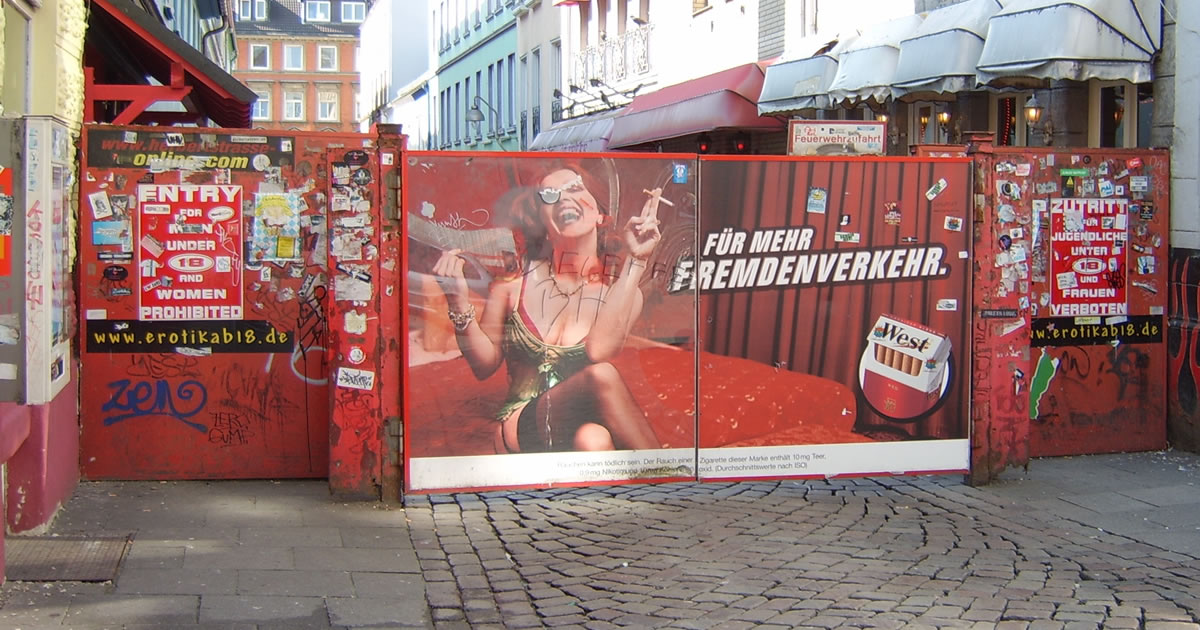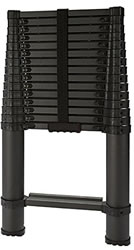“Zutritt für jugendliche unter 18 und frauen verboten”
read the bold red sign, prominently displayed across the gated entrance to Herbertstraße.
“What does that sign say?” Erika asked, as we strolled through Hamburg’s red light district towards the infamous Reeperbahn, on a freezing January evening.
My total knowledge of the local language came from six months of high school German, combined with the odd word or two I had picked up while watching World War II movies with my grandfather.
That meant I knew just enough to feign ignorance and keep on walking.
Giving my best Gallic shrug imitation, I attempted to walk past.
As is their wont, the gods laughed at my cunning plan. At the other end of the gate was the same sign, this time in English:
“Access for teenagers under 18 and women forbidden”.
“That is outrageous!” exploded Erika. “That is discriminatory! Sexist! Misogynistic! Illegal!”
Having been told she wasn’t allowed to go somewhere, Erika was sure as hell going to go there now!
Our plans abandoned, she stormed past a couple of startled looking guys and through the red gate.
There was some angry shouting, and then I heard Erika give an aggrieved shriek.
I sighed, and ran through the gate after her.

Gateway to Herbertstraße. Image credit: Bernd1968.
It turns out Herbertstraße follows in the tradition of Amsterdam’s De Wallen district. A short street lined with dimly lit shop windows, where scantily clad prostitutes attempted to entice horny tourists to sample their wares.
A soaking wet Erika stood glaring at an unliked proportioned naughty nurse.
The nurse held an empty bucket and was animatedly suggesting where Erika should go next, and what she could do once she got there.
The nurse was joined by Cat Woman and a very cold looking Lady Godiva. The shouting swiftly escalated, as punters and tourists alike paused their window shopping to witness the uproar.
I swiftly stepped between them, and steered the now shivering Erika back out of the gate.
“Miststück! Das ist peniswasser!” shouted the nurse, waving dismissively.
Even Erika’s very rudimentary German was able to translate that. Suffice to say the bucket contained more than just water.
“Eiww!”
Designed to fail
After much ranting, a hot shower, and a change of clothes later Erika had finally shouted herself out.
Later that night, sitting in the hotel bar, Erika observed that the walled entrance to Herbertstraße had been designed to fail.
It wouldn’t stop the Paparazzi from taking happy snaps of stupid celebrities behaving badly.
Vengeful wives and slighted partners could still catch their philandering fellows in the act.
Telling teenagers not to do something is a very effective way of getting them to do that exact thing.
Space saver
I was reminded of Erika’s observation earlier today while I was changing a tyre on my rental car.
After emptying all the luggage out onto the side of the road, I lifted the floor of the car boot, expecting to find a spare wheel.
Instead, I discovered a very tired looking skinny “space saver” wheel. It looked like it belonged on a bicycle.
The space saver had worn warning sticker on the side stating that it had a maximum speed of 80km/h. Below that was a disclaimer that it should only be used as an interim measure to get the vehicle to a garage for a new tyre.
A job it already appeared to have performed several times in the past.
As I wrestled with the tyre iron to remove the wheel nuts, my imagination wandered.
I pictured the design review committee meeting, where some slick consultant presented a highly polished business case espousing the cost savings of replacing the traditional functional spare wheel with this half-assed “space saver” temporary wheel.
“Boot capacity will increase.
Cars can be lower profile.
Reduced weight makes the vehicle more efficient, it is good for the environment.
Best of all, it creates a new income stream selling replacement ‘space saver’ wheels.”
Short-sighted middle-managers grinning and nodding, picturing their annual bonuses increasing.
Deciding to replace a fit-for-purpose product with something demonstrably inferior in almost every way.
Something that was designed to fail.
What vanishingly small percentage of customers look at the spare wheel when taking a test drive? Hardly any.
Would anyone notice?
Would anyone really care?
Once the customer has purchased the car, they are locked into the “space saver” replacement cycle.
If the designers were willing to make this kind of compromise with the spare wheel, where else might they have cut corners in pursuit of short term profit gains?
I thought about what that meant for the brand. Short term gain, long term harm?
The trouble with toner
I’ve long been amused at the economics of the home laser printer market.
Back in the olden days, you’d buy a printer and it would ship with a cartridge of toner.
The total price was roughly the same as the cost of a replacement toner cartridge. That meant the printer itself was essentially “free”.
Presumably, the idea was that once customers owned the printer, they would feel locked into purchasing expensive replacement toner cartridges.
The business model was much like that of being a drug dealer. Subsidise the customer’s introduction to the product and get their habit established, safe in the knowledge that over the lifetime of the customer they would likely earn back their initial investment and far more beyond.
Of course, once that first toner cartridge ran out, customers could just junk the printer and buy a shiny new one. Except many won’t, for a multitude of factors ranging from environmental impact through to the psychological sunk cost fallacy of feeling compelled to “get value out of a major purchase”.
In a similar product development committee meeting, the printer designers made a similar decision to the car manufacturers. Swap out the fully loaded toner cartridge sold with new printers, and replace it with an exactly the same sized cartridge that is only partially filled.
Reduce the utility of the product.
Shorten the duration of that initial toner replacement lifecycle.
Would anyone notice?
Would anyone really care?
Tradeshow swag
Anyone who has ever wandered around a trade show will have ended up with a collection of swag.
Exhibitors invest time and money coming up with novel branded products that they hope will end up on a decision maker’s desk, and keep their brand visible.
Swag has diversified somewhat since the days of the ubiquitous branded biro or USB memory. The last trade show I attended had branded giveaways including:
- Phone charging cables
- Laptop camera blockers
- Screen cleaning cloths
- Multitools
- Headphones
- Pedometers
- LED Torches
- Collapsible “to go” coffee mugs
But here is the thing. The quality of the products was generally similar to what you’d expect to find in the pound shop.
Cheap.
Tacky.
Tat.
What does it say about your brand, if you’re promoting yourself using coffee cups that leak?
Torches or pedometers which have batteries that run out the first time they are used?
Provides free malware with every memory stick?
Charging cables that only intermittently work?
Headphones with crappy sound?
If the trade show stall is the vendor’s shop window, doesn’t that make the takeaways (brochures, swag, etc) similar to a candidate resume?
The thing that gets left with the decision maker who has money to spend?
What does it say about a vendor, if they ably demonstrate to every prospective client that they lack the judgement or attention to detail required to get their marketing right?
Of course, any client who makes their procurement decisions based upon swag or corporate hospitality deserves everything they get!
Focusing on the wrong things
In all these examples the folks with a product to sell have focussed on the wrong things. Allowing short-termism to overrule strategic thinking and playing the long game.
That made me wonder how often do we fall into that trap in our own lives?
Driving miles across town to save a couple of pennies on fuel.
Remaining in a shitty job working for a pointy-headed boss because we let ourselves be trapped by golden handcuffs. The lure of that annual bonus. Those vesting stock options.
Booking that slightly cheaper flight from the airport far away from town, while forgetting to place a premium on the time spent getting to and from the airport.
Chasing investment funds that have outperformed, while ignoring the fees structures that share the profits when the fund makes money but leaves the investor eating the full cost of any losses.
When our immediate short term desires dominate what is good for us in the longer term, it often leads to suboptimal (and expensive) outcomes.

Telescopic ladder. Image credit: Xtend & Climb.
The American guy working at the depot, where I swapped the rental car for one with four functional tyres, told me a funny story that dramatically brought this to life.
The US government is proposing to spend around USD$21 billion constructing a wall along the border with Mexico. They published the required specifications and invited firms to tender for the work.
Eight prototypes were constructed, at a cost of around USD$500,000 each. These were subjected to all manner of testing including cutting torches, concrete saws, and jackhammers.
Meanwhile, all along the border sales of telescoping retractable ladders surged.
That USD$21,000,000,000 investment defeated by a humble USD$300 hardware store ladder!
I have no idea if his story was true, but it did make me laugh.
References
- Federal Business Opportunities (2017), ‘Design-Build Structure Solicitation Number: 2017-JC-RT-0001’, US Customs and Border Protection
- Northfield, R. (2018), ‘Trump’s “big, beautiful wall” – which design will win?’, Engineering & Technology


[HCF] 10 April 2019
Wow, I had no clue those streets have these rules, never had the chance to check out. A truly disturbing experience. Have this changed since this happened? In todays liberal times I would assume if a woman wants to watch other women she could. Interesting. Ok that’s not the point here 🙂
Sadly we can face this disappointing “designed to fail” blueprint almost everywhere. It paves the road of how production happens. It makes me sick. It is often the case when with a little bit of mindfulness the same effort which produced a poor product could lead to a good product. But maybe that better version does not look that good on paper in terms of the sheer numbers… [insert Cersei doing the Shame! walk meme here]
I was also always offended by the printer and toner prices but we could see another interesting phenomenon here. Similarly to the action-reaction thing when something illogical happens some folks with the hacker mindset immediately try to fix it. I did not use printers much but my peers who did, went like, buy the printer, use the cartridge until it goes empty, buy a new brand one (or a good quality copy) and then when it goes empty next time refill it. Inkjet printers were easy to refill, I used to help with it to my in-laws and you were able to fill it 3-4 times for the price of a new one. Later, with laser printers they just brought the toner to the refill shop. As far as I can remember it was also 1/3 of the price of a new one.
This wall story reminds me of the good old anecdote of Americans spent precious time and money developing a pen which can be used in space while Russians used a pencil. We know now it is a myth but the message still stands strong.
{in·deed·a·bly} 10 April 2019 — Post author
Thanks HCF.
The planned obsolescence aspects of things designed to fail annoys me.
Smart phones and cars are two good examples of this, cost a fortune but with planned useful lives that are alarmingly short.